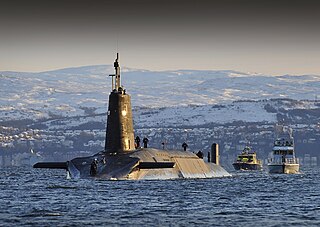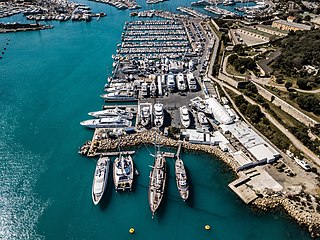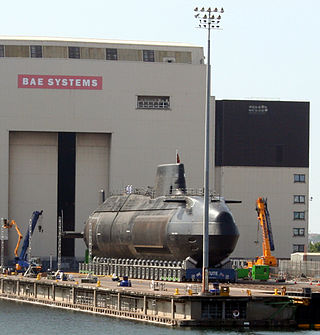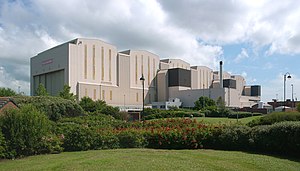The Resolution class was a class of four nuclear ballistic missile submarines (SSBN) built for the Royal Navy as part of the UK Polaris programme. Each submarine was armed with up to 16 UGM-27 Polaris A-3 nuclear missiles.

The Vanguard class is a class of nuclear-powered ballistic missile submarines (SSBNs) in service with the Royal Navy. The class was introduced in 1994 as part of the Trident nuclear programme, and comprises four vessels: Vanguard, Victorious, Vigilant and Vengeance, built between 1986 and 1999 at Barrow-in-Furness by Vickers Shipbuilding and Engineering, now owned by BAE Systems. All four boats are based at HM Naval Base Clyde , 40 km (25 mi) west of Glasgow, Scotland.

The Astute class is the latest class of nuclear-powered fleet submarines (SSNs) in service with the Royal Navy. The boats are being constructed by BAE Systems Submarines at Barrow-in-Furness. Seven boats will be constructed: the first of class, Astute, was launched by Camilla, Duchess of Cornwall, in 2007, commissioned in 2010, and declared fully operational in May 2014. The Astute class is the replacement for the Trafalgar-class fleet submarines in Royal Navy service.

A shipyard, also called a dockyard or boatyard, is a place where ships are built and repaired. These can be yachts, military vessels, cruise liners or other cargo or passenger ships. Compared to shipyards, which are sometimes more involved with original construction, dockyards are sometimes more linked with maintenance and basing activities. The terms are routinely used interchangeably, in part because the evolution of dockyards and shipyards has often caused them to change or merge roles.

Barrow-in-Furness is a port town and civil parish in the Westmorland and Furness district of Cumbria, England. Historically in Lancashire, it was incorporated as a municipal borough in 1867 and merged with Dalton-in-Furness Urban District in 1974 to form the Borough of Barrow-in-Furness. The borough was merged into the new Westmorland and Furness district in 2023. At the tip of the Furness peninsula, close to the Lake District, it is bordered by Morecambe Bay, the Duddon Estuary and the Irish Sea. In 2021, Barrow's population was 55,489, making it the second largest urban area in Cumbria after Carlisle, and the largest in the Westmorland and Furness unitary authority.
HMS Artful is the third Astute-class nuclear-powered fleet submarine of the British Royal Navy. She is the second submarine of the Royal Navy to bear this name. Artful was ordered from GEC's Marconi Marine on 17 March 1997, and was constructed at Barrow in Furness. She was named on 20 September 2013, was rolled out of the shipyard construction hall on 16 May 2014, and was due to start sea trials in early 2015. Artful made her first successful basin dive in October 2014, and sailed on 13 August 2015 for sea trials. Artful was handed over the Royal Navy on 14 December 2015, and commissioned on 18 March 2016.
The Rolls-Royce pressurised water reactor (PWR) series has powered the Royal Navy's nuclear submarines since the Valiant class, commissioned in 1966.

A nuclear submarine is a submarine powered by a nuclear reactor, but not necessarily nuclear-armed. Nuclear submarines have considerable performance advantages over "conventional" submarines. Nuclear propulsion, being completely independent of air, frees the submarine from the need to surface frequently, as is necessary for conventional submarines. The large amount of power generated by a nuclear reactor allows nuclear submarines to operate at high speed for long periods, and the long interval between refuelings grants a virtually unlimited range, making the only limits on voyage times being factors such as the need to restock food or other consumables. The limited energy stored in electric batteries means that even the most advanced conventional submarine can remain submerged for only a few days at slow speed, and only a few hours at top speed, though recent advances in air-independent propulsion have somewhat ameliorated this disadvantage. The high cost of nuclear technology means that relatively few of the world's military powers have fielded nuclear submarines. Radiation incidents have occurred within the Soviet submarines, including serious nuclear and radiation accidents, but American naval reactors starting with the S1W and iterations of designs have operated without incidents since USS Nautilus (SSN-571) launched in 1954.

Barrow Island is an area and former electoral ward of Westmorland and Furness, Cumbria, England. Originally separate from the British mainland, land reclamation in the 1860s saw the northern fringes of the island connected to Central Barrow. Barrow Island is also bound to the south and east by the town's dock system and to the west by Walney Channel. The Ward population taken at the 2011 census was 2,616.

BAE Systems Submarines, is a wholly owned subsidiary of BAE Systems, based in Barrow-in-Furness, Cumbria, England, and is responsible for the development and production of submarines.

The Royal Navy Submarine Service is one of the five fighting arms of the Royal Navy. It is sometimes known as the Silent Service, as submarines are generally required to operate undetected.

The Dreadnought class is the future replacement for the Royal Navy's Vanguard class of ballistic missile submarines. Like their predecessors they will carry Trident II D-5 missiles. The Vanguard submarines entered service in the United Kingdom in the 1990s with an intended service life of 25 years. Their replacement is necessary for maintaining a continuous at-sea deterrent (CASD), the principle of operation behind the Trident system.

HMS Audacious is the fourth Astute-class nuclear-powered fleet submarine of the Royal Navy. Several previous vessels of the Royal Navy have borne the name. She was formally named on 16 December 2016 and was launched on 28 April 2017. Audacious was stated to be handed over in January 2021. A parliamentary written answer stated that Audacious was commissioned on 3 April 2020, but her public ceremonial commissioning took place on 23 September 2021.

The Port of Barrow refers to the enclosed dock system within the town of Barrow-in-Furness, England. Morecambe Bay is to the east of the port and the Irish Sea surrounds it to the south and west. The port is currently owned and operated by Associated British Ports Holdings, but some land is shared with BAE Systems Submarine Solutions. Currently consisting of four large docks, the Port of Barrow is one of North West England's most important ports. The docks are as follows: Buccleuch Dock, Cavendish Dock, Devonshire Dock and Ramsden Dock. The port of Barrow is the only deep water port between the Mersey and the Clyde.

Devonshire Dock is the oldest of the four docks which make up the Port of Barrow in Barrow-in-Furness, England. Although the dock falls under the control of Associated British Ports it is currently solely utilised by BAE Systems. Upon completion of the dock, Prime Minister William Ewart Gladstone stated 'Barrow would one day become another Liverpool'. Although its shipbuilding capabilities have exceeded those on Merseyside, the port and dock system itself never fully met James Ramsden's grand vision for the town.

HMS Anson is the fifth Astute-class nuclear-powered fleet submarine of the Royal Navy. She is the eighth vessel of the Royal Navy to bear the name, after Admiral George Anson.

HMS Agamemnon is the sixth Astute-class nuclear-powered fleet submarine of the Royal Navy and is currently under construction. She will be the sixth vessel of the Royal Navy to bear the name, after the legendary Greek king Agamemnon.
The following is a timeline of the history of Barrow-in-Furness, England, United Kingdom.

The Osborne Naval Shipyard is a Royal Australian Navy multi-user facility on the Lefevre Peninsula, at Osborne, South Australia. It is the most advanced shipbuilding facility in both Australia and the Southern Hemisphere. The facility has produced a range of major surface combatants and submerged vessels such as Destroyers, Frigates, Patrol boats and Submarines for the Royal Australian Navy fleet.

















